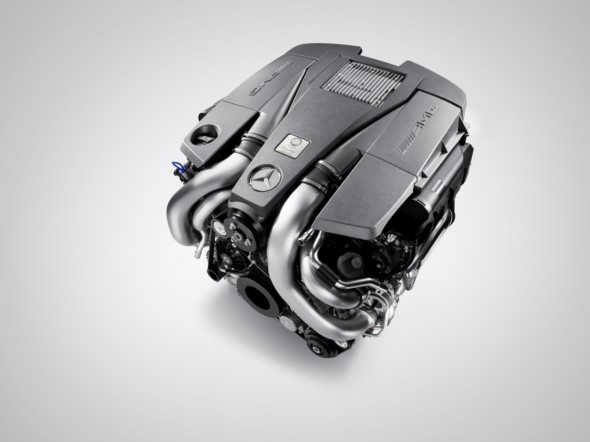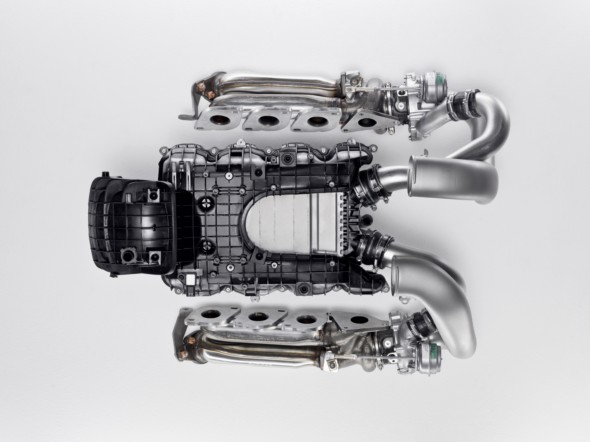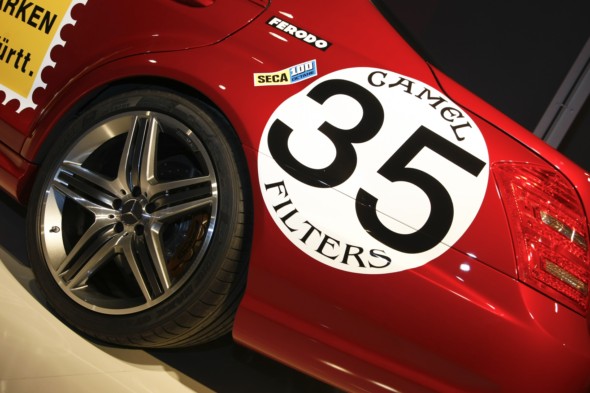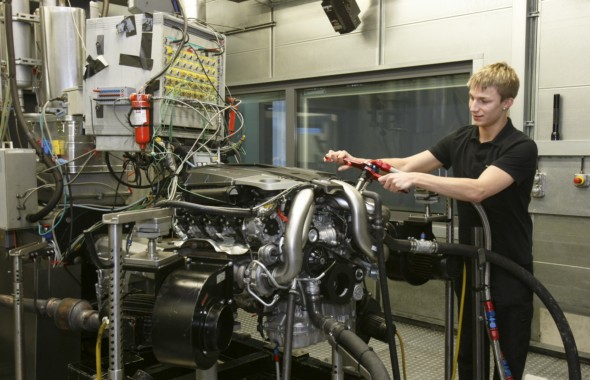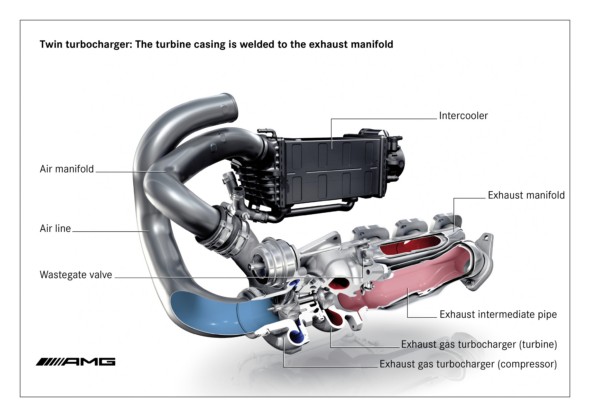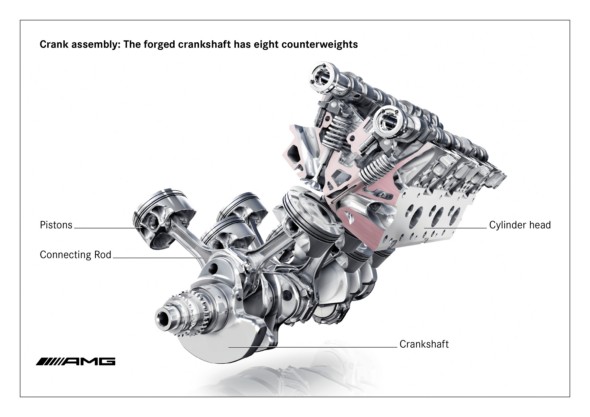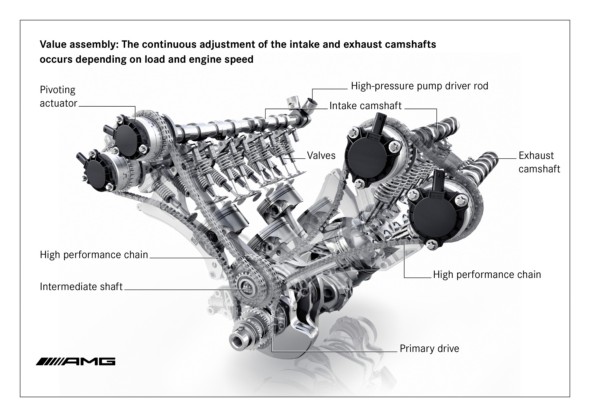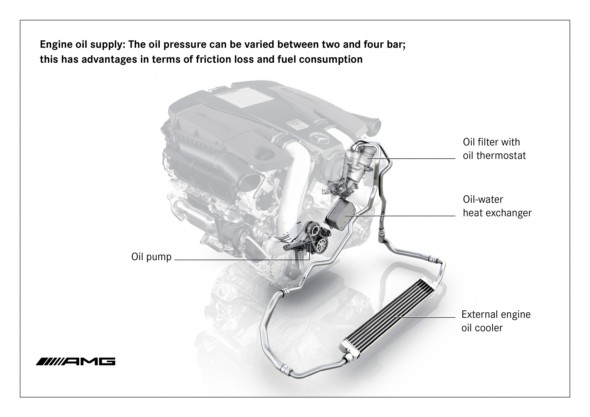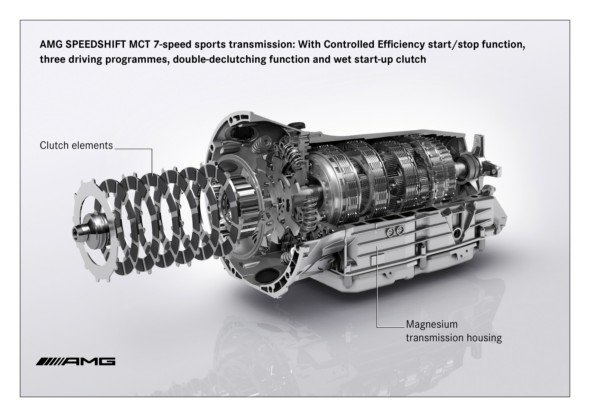Powerful and efficient: an eight-cylinder developing up to 420 kW (571 hp)

- Direct petrol injection with piezo-electric injectors and spray-guided combustion
- Twin turbochargers with air/water intercooling
- Sophisticated engine electronics with Controlled Efficiency start/stop function and generator management
- Aluminium crankcase with ventilation holes to reduce friction
- Continuous camshaft adjustment on the intake and exhaust sides
- Demand-controlled engine oil pump
- AMG SPEEDSHIFT MCT 7-speed sports transmission with a wet start-up clutch and three driving modes
Development goals and design
Perfect combination of performance and efficiency
Emotional peak performance and enormous torque, agile power delivery and a characteristic engine sound, comfort on long journeys and hallmark Mercedes reliability: expectations are high when Mercedes-AMG introduces a new high-performance engine – and its very first biturbo eight-cylinder is no exception.
Two criteria are inexorably gaining in importance, namely efficiency and economy. Mercedes-AMG is confronting the challenges of the future, and demonstrating that dynamic performance can be perfectly combined with fuel economy. The new AMG 5.5-litre biturbo engine combines performance with efficiency to a previously unknown extent.
This is made possible by a unique combination of innovative high-tech systems such as direct petrol injection, twin turbochargers, air/water intercooling and the Controlled Efficiency start/stop function. The eight-cylinder biturbo engine will celebrate its market debut in the new S 63 AMG in September 2010. Mercedes-AMG is systematically following the trend towards increasing efficiency with its new V8 biturbo engine: with a displacement of 5461 cubic centimetres it is precisely 747 cc below the 6208 cc of the naturally aspirated AMG 6.3-litre V8.
Nonetheless it considerably betters it in terms of output and torque. The AMG 5.5-litre V8 biturbo engine develops a peak output of 400 kW (544 hp) and maximum torque of 800 newton metres. In conjunction with the AMG Performance Package these figures increase to 420 kW (571 hp) and 900 newton metres. The torque curve in particular shows that no other engine in this output class is able to match the figures delivered by the new Mercedes-AMG biturbo unit.
Despite an increase in output by 14 kW (19 hp) resp. 34 kW (46 hp) and in torque by 170 and 270 newton metres compared to the naturally aspirated V8, which develops 386 kW (525 hp) and 630 newton metres, AMG engineers have been able to reduce fuel consumption and CO2 emissions considerably.
With a provisional NEDC fuel consumption of only 10.5 litres per 100 kilometres, the new S 63 AMG betters its predecessor by 3.9 litres. This equates to a fuel saving of more than 25 percent, which engine specialists consider to be nothing less than a quantum leap. CO2emissions have likewise been significantly reduced: at 246 grams per kilometre, the figure is 28.5 percent lower than for the previous model (344 g/km). The achievement of these efficiency and environmental aims has no negative effects whatsoever on dynamic performance.
On the contrary, as the new AMG 5.5-litre V8 biturbo fully lives up to AMG’s brand commitment to “performance”: the S 63 AMG accelerates from zero to 100 km/h in 4.5 seconds, and has a top speed of 250 km/h (electronically limited). With the AMG Performance package, the high-performance saloon reaches the 100 km/h mark in 4.4 seconds and reaches a top speed of 300 km/h (electronically limited).
Key figures at a glance: *
Mercedes-Benz S 63 AMG | Mercedes-Benz S 63 AMG with AMG Performance package
Cylinder arrangement V8 | V8
Cylinder angle 90o | 90o
Valves per cylinder 4 | 4
Displacement 5461 cc | 5461 cc
Bore x stroke 98.0 x 90.5 mm | 98.0 x 90.5 mm
Cylinder spacing 106 mm | 106 mm
Compression ratio 10.0:1 | 10.0:1
Output 400 kW (544 hp) at 5500 rpm | 420 kW (571 hp) at 5500 rpm
Output per litre 73 kW (100 hp) | 77 kW (104 hp)
Max. torque 800 Nm at 2000-4500 rpm | 900 Nm at 2500-3750 rpm
Torque per litre 146 Nm | 165 Nm
Maximum engine speed 6500 rpm | 6500 rpm
Mean pressure 18.5 bar | 20.8 bar
Engine weight (dry) 204 kg | 204 kg
Power/weight ratio 0.37 kg/hp | 0.36 kg/hp
Fuel consumption
NEDC combined 10.5 l/100 km | 10.5 l/100 km
CO2 emissions 246 g/km | 246 g/km
Acceleration 0-100 km/h 4.5 s | 4.4 s
Top speed 250 km/h** | 300 km/h**
* provisional figures; ** electronically limited
Combination of twin turbocharging and direct petrol injection
Mercedes-AMG is presenting an attractive high-tech package with its combination of biturbo charging and direct petrol injection with spray-guided combustion. The innovative injection technology brings decisive advantages with respect to fuel consumption and exhaust emissions, thanks to higher thermodynamic efficiency. Particularly fast and precise piezo-electric injectors spray the fuel into the combustion chambers, ensuring a homogeous fuel/air mixture and highly effective combustion.
An electric low-pressure pump delivers the fuel from the tank to a high-pressure pump in the boot with a pressure of six bar. The fuel pressure in the highpressure rail is controlled between 100 and 200 bar on a fully variable and demand-related basis.
Two turbochargers and efficient air/water intercooling Two turbochargers located next to the cylinder banks supply the eight cylinders with fresh air. At their maximum speed of 185,000 rpm under full load, the two turbochargers force 1750 kg of air into the combustion chambers per hour. The maximum charge pressure is 1.0 bar, and 1.3 bar with the AMG Performance package. Thanks to their specific, compact construction – the turbine housings are welded to the exhaust manifold – there are significant space advantages and the catalytic converters also heat up more rapidly.
The new AMG V8 is the first turbocharged engine to dispense with the usual blow-off valve. This neat solution enabled the compressor housing to be made extremely compact. To ensure agile responsiveness with no time lag, all the air ducts in the intake tract are as short as possible.
The wastegate valve, which reduces the pressure in the exhaust system during negative load changes, is vacuum-controlled via an electropneumatic converter. This allows dethrottling under partial loads, which in turn lowers the fuel consumption. As was already the case in the AMG 6.0-litre V12 biturbo engine, the new eightcylinder direct-injection unit uses particularly efficient air/water intercooling. The low-temperature cooler with its water circulation is space-savingly accommodated within the V of the cylinder banks.
It effectively cools down the intake air compressed by the turbochargers before it enters the combustion chambers, and maintains a constantly low intake temperature under full load. A large radiator at the car’s front end ensures defined cooling of the water circulating in the lowtemperature circuit. This guarantees a high output and torque yield in all ambient temperatures and operating conditions. Extremely short charge air ducting makes for outstanding responsiveness. The stainless steel pressure pipes for the fresh and charge air are produced by the hydroforming process, have a wall thickness of only 0.8 millimetres and are designed for particularly low pressure loss. Aluminium crankcase with Silitec cylinder liners The crankcase of the new AMG 5.5-litre V8 biturbo engine is of diecast aluminium. The low (dry) engine weight of just 204 kilograms is the result of uncompromising lightweight construction methods, and leads to the car’s very balanced weight distribution. The bearing cover for the main crankshaft bearings is of grey cast iron, and is bolted to the crankcase for high rigidity. Cast-in Silitec cylinder liners ensure that the eight pistons operate with low friction. Drilled pulsation holes in the crankcase lead to a higher output and fuel savings under partial load: above the bearing blocks there are longitudinally drilled holes which connect adjacent crankcase cavities. Normally the upward and downward movement of the pistons causes air to be forced into and extracted from the sump, which leads to increased internal friction losses and therefore a reduction in output. The pulsation holes prevent this by ensuring effective pressure compensation between the cavities.
The forged crankshaft of high-grade 38MnS6BY steel alloy rotates in five main bearings, has eight counterweights and has been optimised with respect to torsional rigidity, inertia, low rotating masses and a long operating life. A two-mass viscous damper mounted at the front reliably eliminates vibrations. Each connecting rod journal on the crankshaft carries two forged, cracked connecting rods. In the interests of low mechanical friction and high wear resistance, the lightweight pistons have a metallic contact surface. Pressure-controlled oil-spray nozzles in the crankcase ensure that the highly stressed piston crowns are efficiently cooled.
Four-valve technology with variable camshaft adjustment
Perfect charging of the combustion chambers is ensured by large intake and exhaust valves, of which there are four per cylinder. The exhaust valves, which are subject to high thermal loads, are hollow and sodium-cooled. Four overhead camshafts operate the 32 valves via low-maintenance, low-friction cam followers.
The infinitely variable camshaft adjustment within a range of 40 degrees on the intake and exhaust sides depends on the engine load and engine speed, leading to outstanding output and torque values. This also results in consistent idling at a low speed. Depending on the engine speed, valve overlap can be varied for the best possible fuel/air supply to the combustion chambers and efficient removal of the exhaust gases.
The variable camshaft adjustment is carried out electromagnetically via four pivoting actuators, and is controlled by the engine control unit. The camshafts are driven by three high-performance silent chains, which have considerable advantages in noise comfort compared to cylinder roller chains.
Efficient oil supply and water cooling
Efficient oil delivery under all load and operating conditions is ensured by an oil pump with an electrically controlled compression stage. The oil pressure can be varied between two and four bar, which has advantages in terms of friction and fuel consumption. An extraction stage integrated into the oil pump for the two turbochargers prevents oil from being entrained into the charge air and exhaust gases, thereby helping to reduce emissions even further. Both the sump and the extraction point have been optimised for maximum lateral acceleration and efficient lubrication. The oil capacity is 10.5 litres.
The combined water/oil cooling system is a particularly clever solution: initially the engine oil only flows through the oil/water heat exchanger. If the cooling performance of the very compact cooler is insufficient, the flow is directed through the external engine oil/air cooler by an oil thermostat. The advantage of this system is that the engine oil warms up more rapidly, as the engine coolant warms up faster and the oil is later cooled by the coolant. A selectable water thermostat ensures rapid warming of the coolant when starting the engine and driving off.
The engine coolant is cooled on the particularly effective crossflow principle. There is a transverse flow of coolant through both the crankcase and the cylinder heads. Additional cooling slots in the cylinder head ensure more efficient cooling of the combustion chambers, which has advantages during combustion: it enables earlier ignition timings to be chosen without incurring the risk of knocking.
Highly efficient engine electronics for every function
All the engine functions are executed and controlled by a particularly efficient Bosch MED 17.7.3. control unit. This state-of-the-art engine computer not only controls the direct petrol injection, charge pressure, camshaft adjustment and variable oil supply, but also communicates with all the other onboard control units.
The microprocessor has more than 30,000 different parameters and functions stored in its memory, and is able to perform up to 260 million individual operations per second. To reduce the load on the engine control unit, the eight individual ignition coils have an integral electronic module known as an ignition amplifier at each cylinder.
These ensure a strong ignition spark at all engine speeds and under all load conditions. Eight high-voltage powerstages are responsible for highly precise fuel distribution to the piezo-electric injectors. Effective emissions technology with new catalytic converter boxes Low exhaust emissions, compliance with country-specific standards and a characteristic AMG engine sound – the requirements for the exhaust system of the new AMG 5.5-litre V8 biturbo engine were manifold and complex.
The S 63 AMG complies with all the current EU-5 emission standards, as well as meeting all the requirements of the US market (LEV-II standard, On-Board Diagnosis II and lambda sensor diagnosis). The turbochaders are welded to the exhaust manifolds, while air gap-insulated manifolds with a wall thickness of only 1.0 millimetre ensure a rapid catalytic converter response. For efficiency and to save space, this concept has a tandem catalytic converter housing on each side of the vehicle: adjacent to the firewall, two thin-walled ceramic substrates are grouped into each housing.
This solution makes the previous, additional underbody catalytic converters unnecessary. The two ceramic substrates differ to ensure rapid and efficient emissions control: the front one is coated with palladium, while the rear one has a bimetal coating of palladium and rhodium. One lambda sensor per row of cylinders is located in front of each catalytic converter housing, and there is a lambda diagnostic sensor between each of the two thin-walled substrates.
The lambda sensors are necessary for demand-related lambda control. In all operating conditions, the constituents of the intake mixture can be precisely controlled to avoid damaging the catalytic converters. This also benefits the fuel consumption under full load, as the mixture can be leaner than in engines without this control system.
Twin-pipe AMG sports exhaust system for a characteristic sound signature The twin-pipe AMG sports exhaust system has a pipe cross-section of 70 millimetres from the manifolds to the rear silencers. When designing the sound, the aim was to create a perfect synthesis of perceived dynamism and the comfort on long journeys that is the hallmark of a Mercedes. The goal of the developers was to achieve an emotional experience when accelerating and double-declutching,
but unobtrusiveness at constant speeds. Unpleasant frequencies or droning noises were effectively eliminated during a series of painstaking tests. As a result, the striking pair of twin tailpipes of the AMG sports exhaust system emit a sonorous eight-cylinder sound that is typical of AMG.
Power transmission and start/stop function
Intelligent solutions for maximum driving pleasure and low fuel consumption
Seven gears, three driving modes and a double-declutch function: the power transmission of the new S 63 AMG guarantees great emotional appeal and sheer driving pleasure. At the same time the AMG SPEEDSHIFT MCT 7-speed sports transmission makes a considerable contribution to fuel economy – and specifically in combination with the new Controlled Efficiency start/stop function and generator management included as standard features. Accordingly the AMG MCT transmission impresses with a combination of unique functions which no other manufacturer is able to offer in this form.
The AMG SPEEDSHIFT MCT 7-speed sports transmission is an innovative power transfer system that made its debut in the high-performance SL 63 AMG Roadster in 2008, and has also been in use in the E 63 AMG since summer 2009. It combines the sporty, direct and agile feedback of a manual transmission with the maximum convenience of an automatic transmission. Featuring seven gears, three driving modes and a double-declutch function, the 7-speed sports transmission offers superb versatility. MCT stands for Multi-Clutch Technology and indicates that only clutch elements are employed to perform gearshifts.
A wet start-up clutch, which runs in an oil bath, replaces the conventional torque converter. Thanks to its low rotational inertia, the transmission responds instantaneously and dynamically without the losses typical of a torque converter transmission – thereby helping to save fuel. The AMG sports transmission also impresses with its low weight of just 80 kilograms, which has been made possible through the use of lightweight magnesium for the transmission housing. Vibrations are effectively eliminated by a new, two-stage torsion damper, with resulting benefits in perceived passenger comfort.
Controlled Efficiency (“C”) driving mode for optimum fuel economy During its development and adaptation to the new AMG 5.5-litre V8 biturbo engine, the AMG engineers paid special attention to the new Controlled Efficiency driving mode (“C”). The emphasis was on delivering minimum engine speed coupled with a reduced number of gearshifts in all driving situations. When moving off in “C”, the MCT transmission always selects second gear and shifts decidedly early to the next higher gears if the driving style permits.
At 60 km/h for instance, sixth gear will already be engaged – not only improving fuel consumption but also noise levels. Thanks to its powerful, readily available torque even at low engine speeds, the AMG V8 biturbo unit is absolutely ideal for this style of driving. Controlled Efficiency also means convenient gearshifts and a “soft” accelerator response set-up for outstandingly smooth power transfer.
Controlled Efficiency start/stop function as a new feature at Mercedes-AMG The Controlled Efficiency start/stop function is also being used in an AMG model for the first time. This system is standard equipment in the new S 63 AMG, and permanently active in the fuel economy driving mode “C”. Once the driver comes to a halt e.g. at a red traffic light, the V8 engine is automatically switched off.
Once the brake pedal is released or the accelerator is depressed, the engine is immediately restarted and the car is able to move off quickly. Intelligent technology guarantees a comfortable and immediate starting procedure: a crankshaft sensor which recognises the direction of rotation registers the resting position of all eight pistons. For an automatic engine start, the cylinder with the most favourable piston position receives an injection of fuel into its combustion chamber.
The precise piezo-electric injectors greatly assist this process, as they make particularly fast starts possible. The engine management ensures that the engine is only switched off if certain preconditions are met. The starter battery must have sufficient charge, for example, and the engine must be at the necessary operating temperature for efficient emissions control.
The same applies to the interior temperature selected by the driver: if this has not yet been reached, the engine is not switched off when the car comes to a stop. The onboard network management system makes sure that active audio, telephone or video functions are not interrupted by the start/stop function.
A green “ECO” symbol in the AMG main menu shows the driver that the Controlled Efficiency start/stop function is active. Should one of the above criteria be preventing activation of the system, this is shown in the central display by the message “Start/stop inactive” and a yellow “ECO” symbol. In the two more performance- oriented driving modes “S” (Sport) and “M” (Manual), the start/stop function is always deactivated. If required, the driver can also switch it off while in “C” mode as well.
The eight-cylinder biturbo engine also features the generator management system familiar from the E 63 AMG: whenever the engine is on the overrun or when braking, kinetic energy is used to charge the battery rather than being wasted as heat in the usual way. In all other operating modes a combination of onboard network and generator management enables the generator to be kept at a low voltage.
This reduces the load on the engine and makes for fuel savings of around 0.15 litres per 100 kilometres according to the NEDC standard, and up to 0.2 l/ 100 km in city traffic with its frequent overrun and braking phases. Drive modes “S” and “M” for even more driving pleasure and dynamism The engine and transmission come across as much more agile in the “S” (Sport) mode.
Accelerator pedal movements trigger a more direct traction response, making the downshifts more spontaneous. The engine speed is allowed to reach a higher level in each gear, while the gearshifts are around 25 percent faster than in “C”.
In the manual shift mode “M”, gearshifts at full throttle take just 100 milliseconds, a reduction of 50 percent compared to “C”. In “S” and “M” modes, the engine management system partially suppresses the cylinders: interrupting ignition and injection under full load leads to even faster gearshifts than before. The highly emotional vocals are an appealing side effect of this lightning-fast process. Ultra-fast, spontaneous multiple downshifts are another forte of the AMG SPEEDSHIFT MCT 7-speed sports transmission.
For instance, kickdown allows gearshifts straight from seventh down to fourth gear, or from fifth to second. In the “S” and “M” driving modes the automatic double-declutching function is active. Every manual or automatic downshift is accompanied by precisely metered doubledeclutching – incrementally from “S” to “M”.
And this not only adds to the driver’s emotional experience: the load-free downshift minimises load-change reactions, which pays particular dividends when braking into bends – and also enhances safety in the wet or on ice.
No automatic downshifts in manual “M” mode In manual “M” mode the driver also benefits from the high torque of the V8 biturbo engine, as there is no automatic downshift under full load and kickdown; the transmission remains steadfastly in the selected gear. Moreover, the AMG MCT sports transmission does not perform an automatic upshift in manual mode when the rev limit is reached. In “M” mode the AMG instrument cluster displays the current gear and alerts the driver to the need for an upshift just before the needle reaches the red zone.
This means that a particularly sporty driver can use the superior performance potential to its fullest extent. When approaching the lower rev limit, e.g. when braking the vehicle, there is an automatic downshift to the next lower gear. The gears can be shifted using the steering wheel shift paddles – whatever the driving mode. The electronic key for selection of the three driving models is located to the left of the COMAND controller.
The powerful electronic transmission control unit with its integrated 80 MHz processor guarantees immediate downshifts – for example when approaching traffic lights or if the driver requires fast acceleration when overtaking.
Development, trials and test bench technology Endurance testing the exclusive high-tech powerpack Development work on the new AMG 5.5-litre V8 biturbo engine began in 2006. The programme initially involved basic research for a synthesis of top-class performance, powerful torque and potential fuel savings. It quickly became clear that the spray-guided combustion principle exclusively developed by Mercedes-Benz should be combined with twin turbochargers.
The development work on the new eight-cylinder biturbo unit started with fundamental packaging research, analyses of basic mechanical functions, the oil and coolant circuits and the power characteristics with various intake duct and camshaft configurations, plus the definition of fuel injection quantities, fuel consumption and exhaust emission values – all these were studied by means of flow simulations and on the dynamic simulation test benches at Mercedes-AMG.
Nine of the very latest, high-tech test benches are available in the Mercedes-AMG test bench laboratory, which was taken into commission in 2004; engines with outputs exceeding 735 kW (1000 hp) can be dynamically tested in this facility.
These test facilities are able to simulate any road and environmental conditions to reproduce any conceivable type of operation. Cold or hot starting, mountain passes, stop-and-go traffic or fast laps on the North Loop of the Nürburgring – the engines were required to give their utmost. Even the intake air temperatures and densities can be varied by computer control, and the engines can be alternately filled with hot and cold coolant. Fuels of different grades are also available.
The goal of the detailed bench tests was to verify the performance of all the engine components, including the peripheral units. All the measurement data for the engines examined were systematically compared, and evaluated using reproducable test methods. To ensure the very highest quality standards, the new V8 engines themselves were required to undergo 17,000 hours of endurance testing.
In conjunction with the AMG SPEEDSHIFT MCT 7-speed sports transmission, the final test was a 4000-hour endurance test on a special engine/transmission test bench.
Extensive trials in every climatic zone on earth At the same time the first test engines had to prove their worth in practical trials. Whether in the icy cold of northern Sweden, the merciless heat of Death Valley (USA), lapping the high-speed circuits in Nardo (Italy) and Papenburg (Germany) or in stop-and-go traffic in inner-city Stuttgart – the standardised test programme of Mercedes-AMG includes all climatic zones and route profiles.
At the same time it makes the very highest demands on the day-to-day practicality, reliability and long-term durability of the new engine/transmission combination. All in all, the different AMG test vehicles covered around 700,000 kilometres of mixed endurance testing on the roads.
Special tests for the new start/stop function The test engineers paid particularly close attention to the operation of the new start/stop function, for which purpose they undertook extended journeys in the stop-and-go traffic of various major cities.
This enabled the interaction between the different engine and transmission control units to be painstakingly examined, as well as the influence of the ambient temperature on the operating modes of the new V8 engine. Another major focus was on the vital further development of the control software, and its constantly necessary application to the different onboard systems.
One man, one engine – highly qualified manual assembly in Affalterbach
In contrast to large-series production, every Mercedes-AMG engine is traditionally assembled by hand according to the “one man, one engine” philosophy. A single AMG technician assembles the complete engine in the AMG engine shop in Affalterbach, and is therefore responsible for everything from the installation of the crankshaft in the engine block to the assembly of the camshaft and the cables and oil fill-up – his signature is then put on the engine plate.
The special production techniques used in Affalterbach were already taken into account during the design and development phases for the new AMG 5.5-litre V8 biturbo engine, and this opened up new scope and possibilities with respect to engine design.
Electronic documentation of the entire production process During the assembly process, each engine absolves various tests in which it is examined for water and oil leakages. The entire fuel system is also tested for leaks – to the extent that even individual gas molecules can be detected. All the engine functions are then examined on the so-called cold test bench, using simulated resistances and pressurisation as well as the very latest resonance and airborne noise measurement methods.
And finally a fully automatic image processing system is used to check the delivery condition of the completed engine. The assembly process is also controlled and documented by the AMG Trace System. This system provides full documentation of various process parameters such as the tightening torques of all bolted connections, fluid levels, component and batch information and test results. Special PCs are mounted on the assembly trolleys, which have a wireless link to a documentation database. They display Daimler Communications, 70546 Stuttgart, Germany Mercedes-Benz – A Daimler Brand the relevant online information depending on the assembly stage. This state-of-the-art system guarantees exemplary production quality at the highest level. At the same time its unique architecture combines the traditional approach to AMG engine production with the production trends of the future.
Assembly of AMG high-performance engines in Affalterbach
The AMG high-performance engines for the different car models are built in the engine shop, which covers an area of 9950 square metres and occupies two storeys. The production procedures are designed for maximum flexibility.
Depending on the order intake, production can be rapidly adapted in line with current market conditions. Only highly qualified technicians with many years of experience are employed in the AMG engine shop. The utmost precision and attention to detail are a matter of course during the hand-assembly process. All work stages are subject to the stringent Mercedes-Benz quality criteria which also apply to all other seriesproduction engines.
After all, even an AMG high-performance engine must exhibit the reliability and long operating life typical of a Mercedes.
A tradition of top performance
Powerful eight-cylinder engines with a thrilling power delivery and an emotional sound experience – a traditional strength of AMG. The V8 power units from Affalterbach combine high-tech derived from motorsports with the smooth running and exemplary reliability that are the hallmarks of a Mercedes.
The impressive attributes of the powerful eight-cylinder engines produced by Mercedes-AMG have their origins in motor racing. Founded in 1967, the company started with the development of powerful racing engines, and soon used the resulting findings to develop high-performance road models. AMG is regarded as a pioneer in the customising/tuning sector, and over the last four decades it has developed into a manufacturer of exclusive high-performance automobiles thanks to continuous technical innovation.
AMG V8 engines have always been in a class of their own. It all started in 1971, with the 6.8-litre, 315 kW (428 hp) racing engine in the legendary 300 SEL 6.8 AMG. At the 24-hour race in Spa-Francorchamps (Belgium), this fast Mercedes saloon immediately secured a highly acclaimed class victory and second place overall.
The powerful eight-cylinder racing engine made AMG known throughoutthe world overnight. Soon AMG also had a suitable engine available for S-Class customers in search of more power: on the basis of the 184 kW (250 hp) V8 engine of the 300 SEL 6.3, the company developed a 206 kW (280 hp) eight-cylinder unit which gave the luxury saloon the performance characteristics of a sports car.
More than 300 km/h in the 300 CE 5.6 AMG – “The Hammer” Subsequent AMG high-performance engines also provided unprecedented driving pleasure in other Mercedes models. For example the five-litre V8 engine with 203 kW (276 hp), which gave the Mercedes-Benz 280 CE 5.0 AMG a dynamism previously unknown in this vehicle class in 1983. Just one year later AMG came up with a completely independently developed V8 unit featuring four-valve technology and an output of 250 kW (340 hp) – a sensational figure at the time.
In 1986 the V8 engine, which had meanwhile been uprated to 5.6 litres and an output of 265 kW (360 hp), gave the 300 CE 5.6 AMG a maximum speed of no less than 300 km/h – as was even reported on the evening television news . American fans respectfully referred to the fast AMG Coupé as “The Hammer”. The last evolutionary stage of the eight-cylinder powerpack appeared in 1988: from a displacement of six litres, the four-valve unit developed a maximum output of 283 kW (385 hp) and a torque of 566 Newton metres.
As the sporty top model in the completely new Mercedes-Benz E-Class with the twin-headlamp face, the E 50 AMG had its debut in 1996 with a five-litre AMG V8 engine developing 255 kW (347 hp). One year later AMG surprised the motoring world with a 4.3-litre V8 engine in the C-Class: the C 43 AMG developed 225 kW (306 hp), and was also available as an Estate model.
In 1997 AMG also presented the newly developed 5.5-litre eight-cylinder engine with 260 kW (354 hp), threevalve technology and twin-spark ignition. The M 113 initially gave effortless performance to the E 55 AMG, but within a short time it was also used to power other AMG high-performance cars such as the CLK 55 AMG, ML 55 AMG, SL 55 AMG, S 55 AMG, CL 55 AMG and G 55 AMG. Uprated to a peak of 270 kW (367 hp) and 510 newton metres, it also gave a suitably dynamic performance to the C 55 AMG, the CLK 55 AMG Coupé and Cabriolet and the SLK 55 AMG.
Displacement of 5.5 litres, eight cylinders and supercharger technology As a major milestone in the history of AMG engine development, the supercharged 5.5-litre V8 (M 113 K) with up to 380 kW (517 hp) and 720 newton metres of torque celebrated its debut at the end of 2001 in the SL 55 AMG, followed by the S 55 AMG, CL 55 AMG, E 55 AMG, G 55 AMG Kompressor and the CLS 55 AMG.
The supercharged AMG 5.5-litre V8 unit was voted the clear winner in the “International Engine of the Year Awards” in 2003. In the “Best Performance Engine” category, it won a victory over well-established competitors by a wide margin. A further development of the supercharged V8 engine developing 428 kW (582 hp) and 800 newton metres powered the highly exclusive CLK DTM AMG. The supercharged V8 engine of the Mercedes-Benz SLR McLaren presented in 2003 was a special case, as it was a completely independently developed, high-tech eight-cylinder with dry sump lubrication.
This delivered an impressive peak of 478 kW (650 hp) and 820 newton metres. Naturally aspirated eight-cylinder engine with a displacement of 6.3 litres and an output of up to 420 kW (571 hp) 2005 saw the debut of the AMG 6.3-litre V8 engine; depending on the model, this naturally aspirated, high-revving unit known as the M 156 developed up to 386 kW (525 hp) and 630 newton metres.
In 2009 this V8 engine currently used in nine AMG high-performance cars won the “International Engine of the Year Award“ in the “Best Performance Engine” category. Exclusively reserved for the brand-new Mercedes-Benz SLS AMG super-sports car, the M 159 also has a displacement of 6.3 litres, a peak output of 420 kW (571 hp) and a maximum torque of 650 newton metres.
To ensure a low centre of gravity and allow maximum lateral acceleration, this eight-cylinder unit designed as a front-mid-engine features dry sump lubrication. “AMG Performance 2015” as the continuation of a success story Mercedes-AMG is continuing this impressive story with the AMG 5.5-litre V8 biturbo engine and the AMG SPEEDSHIFT MCT 7-speed sports transmission.
The “AMG Performance 2015” strategy reflects the company’s commitment to continuous reductions in both the fuel consumption and emissions of new models – also with future engine/transmission combinations – while reaching new heights with the central brand value of “performance”.

